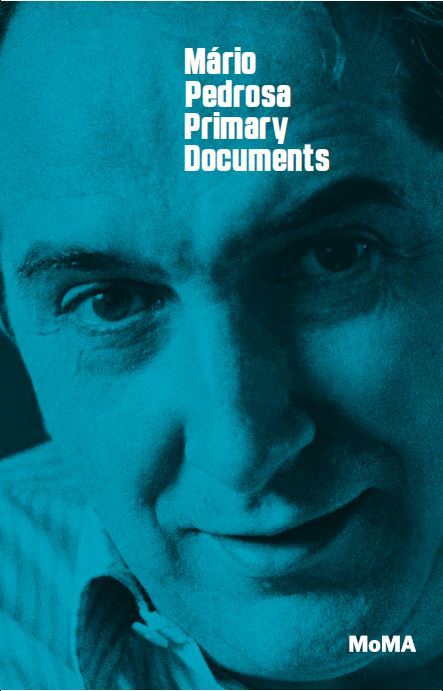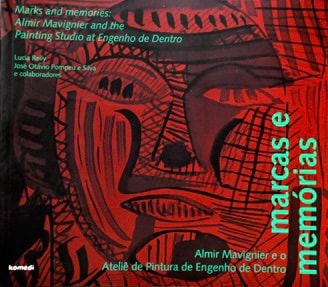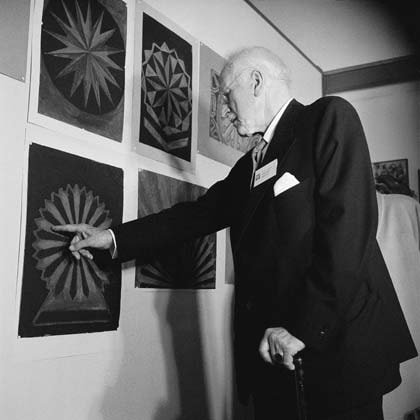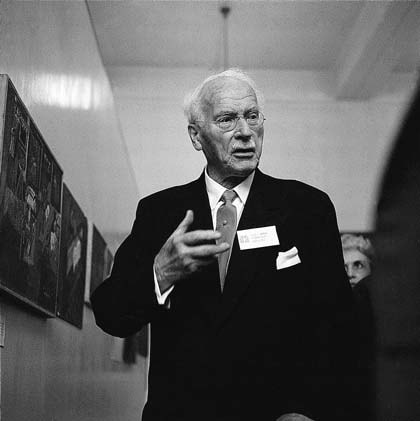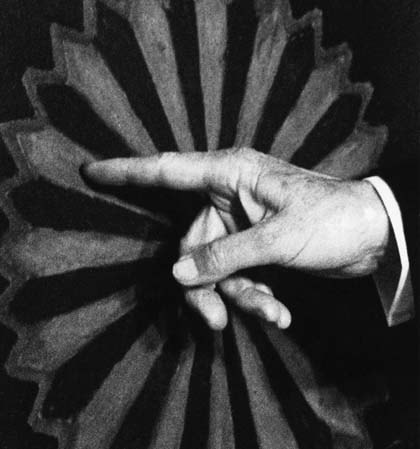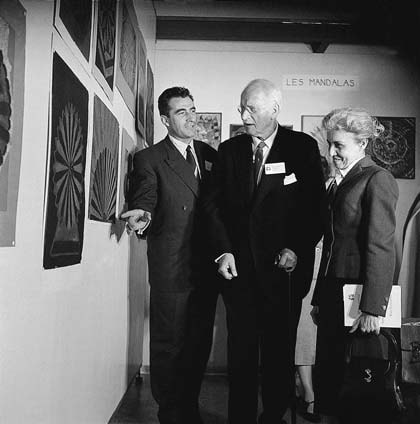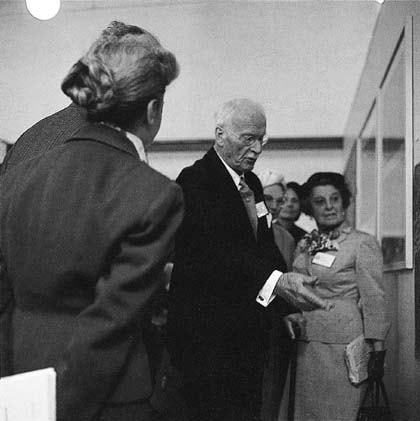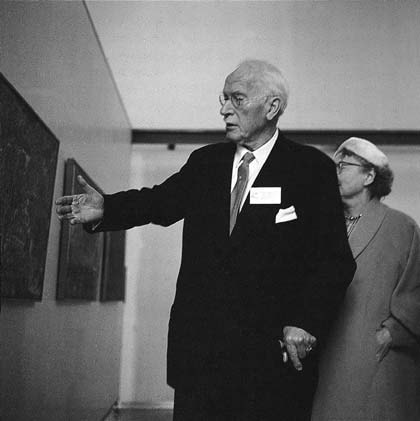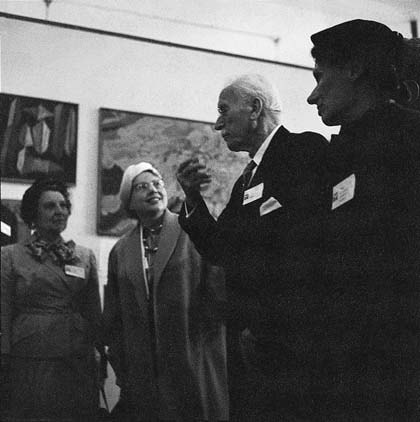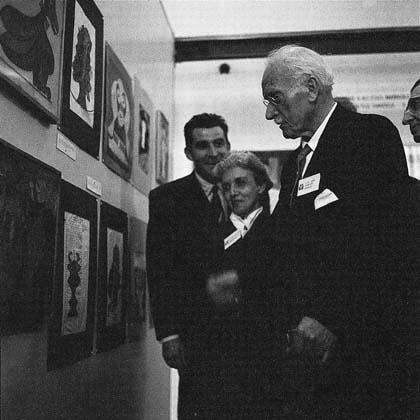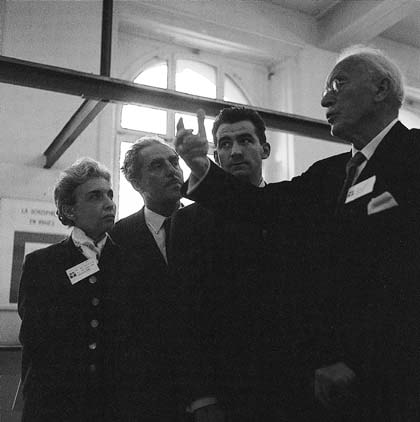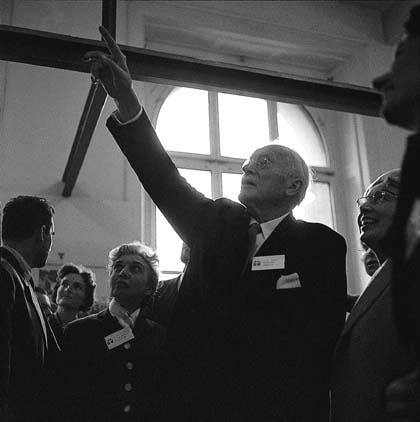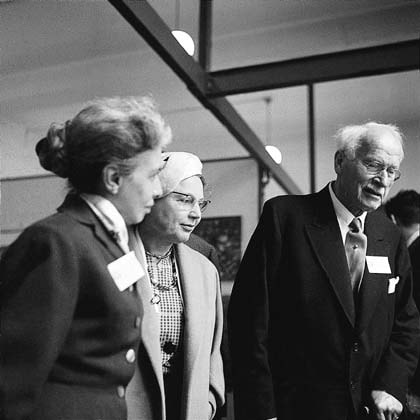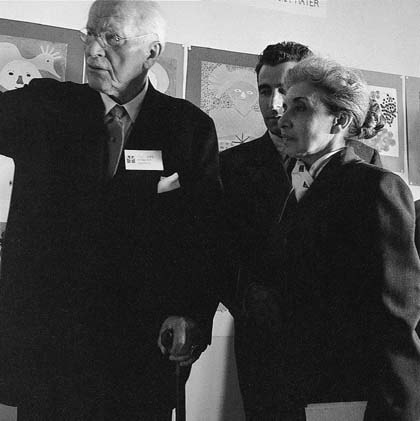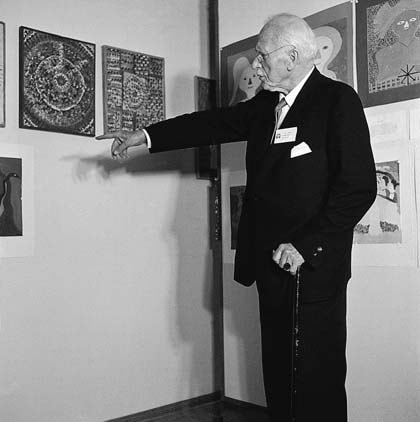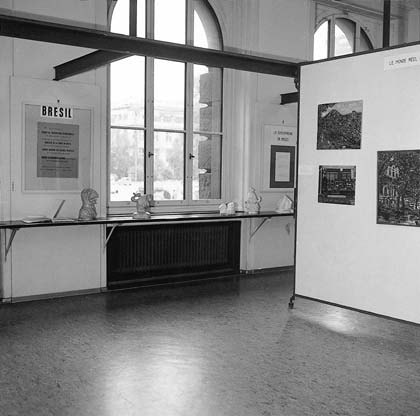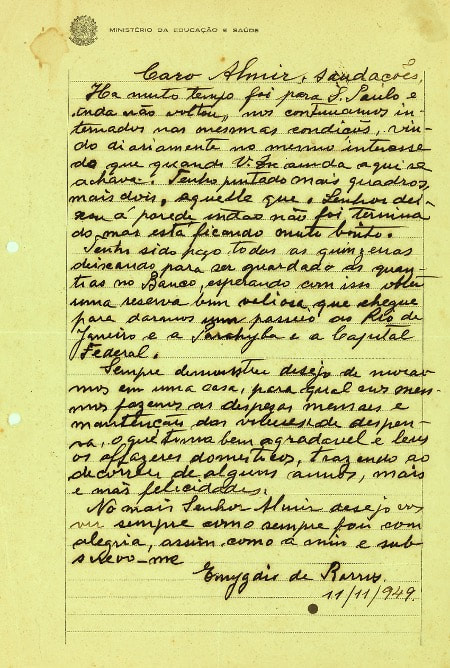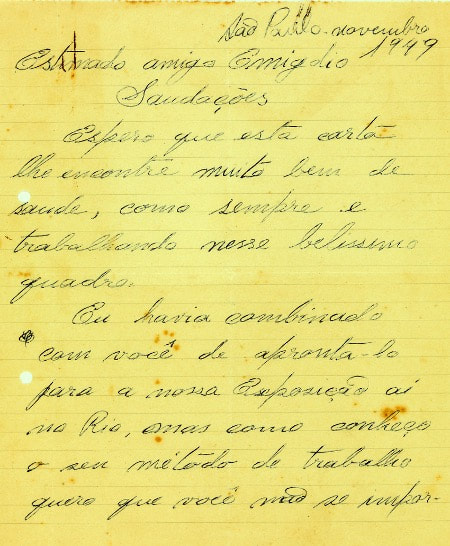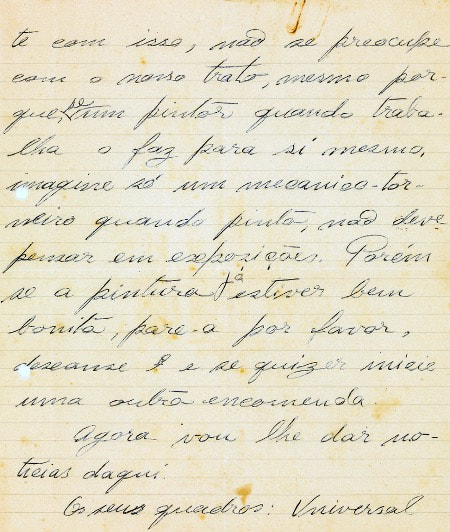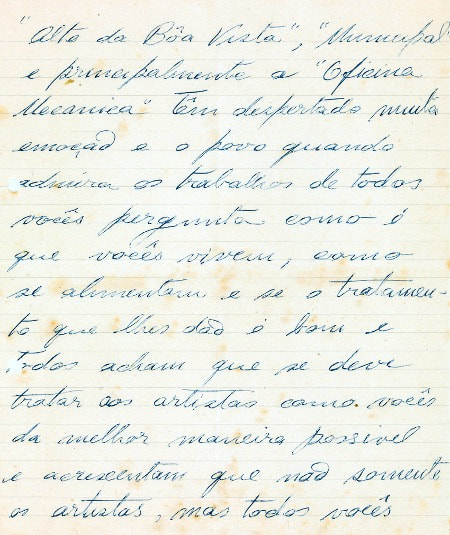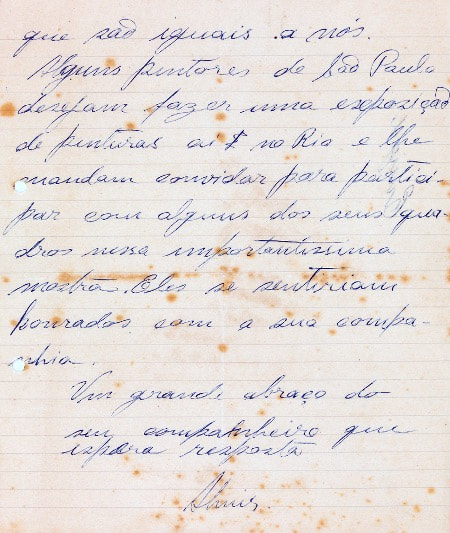|
|
Engenho de DentroEntdeckung des Unbewussten
|
|
Mit 21 Jahren began Almir Mavignier für die Psychiatrie Pedro II Engenho de Dentro in Rio de Janeiro zu arbeiten. Er endteckte, daß unter den Internierten mehrere Menschen mit künstlerischen Ausdrucksfähigkeiten gab und er initiierte die Gründung eines Ateliers, in dem er dann die nächsten fünf Jahre als Monitor oder Betreuer arbeitete. Ohne eine psychiatrische oder pädagogische Ausbildung zu haben und ohne zu versuchen, die internierten anzuleiten, betreute er dieses Atelier, in dem er auch selbst malte. In folge entstanden Werke und Künstler, die große Beachtung fanden, sowohl in der Kunst und dann auch in der Welt der Psychiatrie und das Atelier, die Künstler und vor allem die Leiterin der Beschäftigungstherapie in der Klinik Dr Nise da Silveira, die das Atelier in der Institution durchgesetzt hat, wurden später sehr bekannt.
|
|
Almir Mavignier über seine Zeit am Engenho de dentro in einem kurzen Text (geschrieben 1998):
O Início do Ateliê de Pintura (Almir Mavignier)
O Início do Ateliê de Pintura
Rio de Janeiro Foi o serviço diário de 10 a 15 horas que me levou como pintor a trabalhar no Centro Psiquiátrico Nacional do Engenho de Dentro, de 1946 até novembro de 1951. É sobre esse período que escrevo aqui. A minha função no hospital era a de acalmar doentes agitados. O diretor Paulo Elejalde, porém, me encarregou de realizar projetos para jardins. Durante uma exposição de trabalhos manuais do serviço de praxiterapia, propus a sua diretora, Nise da Silveira, organizar um ateliê de pintura para os internados. A idéia veio de encontro a um antigo projeto seu. O ateliê foi inaugurado no dia 9 de setembro de 1946. Estava organizado nas salas de um edificio central, situado entre quatro hospitais vizinhos, dos quais os internados eram conduzidos diariamente para pintar, trabalhando das 10h às 14h30. Não era arte, senão terapia, que se buscava. Eu, como pintor, e não come psiquiatra, estava, porém, interessado nos artistas a descobrir, procurando-os nos pátios e nas enfermarias dos hospitais. Encontrei assim Adelina Gomes, Carlos Pertuis, Fernando Diniz, Lacio e Raphael Domingues. Outros internados andavam livres, entravam no ateliê e participavam, como Abelardo, Isaac Liberato e Arthur. O meu préprio ateliê foi instalado no hospital, correspondendo à necessidade de colocar um pintor e não um guarda vigilante para dirigir a seção. Não havia aulas, senão conselhos técnicos, como água para aquarela e terebintina para óleo. Não havia reproduções ou revistas de arte, a fim de preservar a projeção de imagens do inconsciente. Os pintores trabalhavam profundamente concentrados, o que os afastava das Influências reciprocas. O trabalho diário contribuiu para a melhora técnica das pinturas. RAPHAEL PESSOALMENTE Conheci o Raphael internado no hospital e o externado em casa. No ateliê do hospital, era introvertido e triste. Em sua casa, alegre e brincalhão, escondendo a chave da casa, o que sua mãe sabia e tolerava. Nas sessões de desenho gesticulava no ar, baixava a pena e deixava linhas sobre o papel como vestígio dos gestos. Durante esse ritual, parava e falava. Uma vez se dirigiu a Mário Pedrosa, advertindo: “Tire o pezinho da cadeira”, ao que Mário imediatamente obedeceu. Por outra ocasião, conduziu a pena em direção à mão de Mário, fazendo um ponto na unha. Sua mãe, pessoa simples, paciente e agradecida pelo interesse das visitas, nunca pôde compreender os elogios aos desenhos, que considerava “escalafobéticos”, o que significa desajeitados, desengonçados ou estrambólicos. Como expressão de agradecimento pelo trabalho, ofereceu várias vezes desenhos belíssimos como presente, que eu “dolorosamente” depositei na coleção do atelié no hospital.
Organizei o atelié do Centro Psiquiatrico como pintor. Pude, portanto, reconhecer o talento do internado para pintar, pela sua sensibilidade ao misturar cores. Os primeiros quadros de Emygdio assinalaram esse talento, o que justificou Ihe comprar material a fim de realizasse grandes telas. Eu o assistia respeitando cua liberdade de criação. A experiéncia do ateliê mostrou as fontes de criação que se encontram dentro, e nao fora do artista. Esse conhecimento influenciou o meu trabalho, fazendo-me realizar uma pintura experimental e não comercial. O ateliê influenciou também a minha atividade pedagógica, no sentido de ajudar jovens artistas a encontrar a sua própria personalidade. Esse conceito me orientou como professor de pintura na escola de Belas Artes em Hamburgo, de 1965 até 1990. Os artistas do ateliê pintavam projetando imagens do trabalhavam como estudantes das inconsciente. Não trabalhavam como estudantes de Belas Artes, que se encontram ligados a uma arte tradicional. Essa tradição se deixa reconhecer como “arte do consciente”, denominação que uso para representar a família internacional de artistas. Os pintores do Engenho de Dentro não pertenciam a essa família. Suas obras fazem descobrir, na história da arte moderna do Brasil, um grupo de artistas incomparaveis, porque não foram influenciados por tendências estrangeiras. Almir Mavignier, Hamburgo 6 julho 1998 The Beginning of the painting studio (Almir Mavignier)
The Beginning of the painting studio
Rio de Janeiro Workdays of from ten to fifteen hours brought me as a painter to work at Engenho de Dentro Psychiatric Center from 1946 to november, 1951. It is this period that I am writing about here. My position at the hospital was to calm down disturbed patients. However, the director Paulo Elejalde gave me the job of carrying out projects in the gardens. During an exhibition of handmade objects done for purposes of occupational therapy, | proposed to the director of that section, Nise da Silveira, to organize a painting studio for the patients. This idea matched plans that she had been considering for some time. The studio was inaugurated on 9 September 1946. It was set up in the rooms of a central building, located between four neighboring hospitals, from which the patients were brought daily to paint, working from 10 a.m. to 2:30 p.m. It was not art, but rather therapy, that was sought. I, as a painter, and not as a psychiatrist was, however, interested in the artists to be found, looking for them in the patios and along ine wards of the hospitals. In this way I found Adelina Gomes, Carlos Pertuis, Femando Diniz, Lúcio and Raphael Domingues. Other patients wandered freely and particioated, as did Abelardo, Isaac Liberato and Arthur. My own studio was set up at the hospital, as the aim was to have a painter and not a guard to take care of the section. There were no classes, but rather the offering of technical advice, such as use water for watercolor and turpentine for oil paints. There were no reproductions or art magazines, In order to preserve the projection of the images from the unconscious. The painters worked in profound concentration, which avoided reciprocal influences among them. The daily contributed to the technical improvement of the paintings. RAPHAEL PERSONALLY I knew Raphael both as a patient in the hospital and while he lived at home. In the hospital studio he was introverted and sad. At home he was happy and playful, hiding the house key, which his mother knew and put up with. At drawing sessions he would gesture in the air, then lower his pen and leave lines on the paper like vestiges of his gestures. During this ritual he would stop and speak. Once he spoke to Mario Pedrosa and admonished, “Get your foot off that chair,” at which Mario instantly obeyed. On another occasion he directed the pen toward Mario's hand, making a dot on his fingernail. His mother, a simple woman, patient and appreciative for the interest of the visitors, was never able to understand the praise given to his drawings, which she considered "scalaphobetic,” which means awkward, ungainly or odd. As an expression of appreciation for my work, on various occasions he offered beautiful drawings to me as a present, which I “painfully” deposited in the hospital studio.
I organized the art studio of the Psychiatric Center as a painter. As such I was able to recognize the talent of the patients for painting, by their sensitivity for mixing the colors. Emygdio’s first paintings indicated this talent, which justified buying materials for him to do large paintings. I watched him while respecting his creative freedom. The experience of the studio showed the sources of creation that are found inside, and not outside the artist. This knowledge influenced my own work, leading me to do experimental rather than commercial painting. The studio also influenced my teaching activity, toward helping artists discover their own personality. This concept guided me as a professor of painting at the School of Fine Arts of Hamburg, from 1965 to 1990. The artists of the studio painted by projecting images. of their unconscious. They didn’t work like students in schools of fine art, who are all connected to a traditional art. This tradition is different from that normally called “art of the conscious”, the term I use here to refer to the international family of artists. The painters at Engenho de Dentro do not belong to this family. Their works allow us to discover, in the history of Brazilian modem art, a group of incomparable artists, because they were not by foreign tendencies. Almir Mavignier, Hamburg 6 july 1998 from the catalogue:
mostra do redescobrimento. nelson aguilar, organisador./ fundação bienal de são paulo. - são paulo: associação brasil 500 anos artes visuais, 2000.. isbn 85-87742-01-9 |
|
Der Künstler Abraham Palatnik, enger Freund Almir's über Engenho de Dentro:
A REVELAÇÃO DO INCONSCÍENTE (Abraham Palatnik)
A REVELAÇÃO DO INCONSCÍENTE ABRAHAM PALATNK O primeiro contato que tive com os artistas do Centro Psiquiátrico do Engenho de Dentro ocorreu em 1948, por intermédio de Almir Mavignier, e teve para mim importante e surpreendente desdobramento. De um lado a recepção carinhosa da Dra. Nise da Silveira, apresentando-me os artistas e seus trabalhos, ao mesmo tempo que explicava o espírito e a filosofia de sua atuação; do outro, minha absoluta perplexidade diante daquilo que estava presenciando. Foi um impacto que demoliu minhas idéias e em relação a arte. Embora tivesse apenas 20 anos de idade, considerava-me um artista consciente, coerente e seguro daquilo que fazia. Diante dos trabalhos de Emygdio de Barros, Raphael Domingues, Carlos Pertuis, Fernando Diniz, Isaac Liberato e outros, entretanto, tive a prova e percebi a extraordinária riqueza e potencial criativo imerso em seus subconscientes, e inevitavelmente comecei a comparar e questionar profundamente aquelas minhas convicções à luz da criatividade espontdnea desses artistas. A confiança em meu aprendizado e atuação durante quatro anos num ateliê livre de artes plasticas estava desmoronando. A coerência estava com Diniz, com Carlos, com Emygdio; a Poesia, com Raphael, com Isaac. Fundiam-se imagem e linguagem. Os elementos determinantes da figura e da cor nao obedeciam a critérios escolares de composic¢do, sendo na verdade regidos por cédigos outros, relacionados a foreas poderosas advindas do inconsciente, cédigos esses que viriam a ser exaustivamente estudados e decifrados pela Dra. Nise. Fascinado e desnorteado, fui pouco a pouco percebendo a importancia de conhecer e compreender outros aspectos da forma e da percepgdo que nao aqueles tradicionais e, por meio do precioso contato com Mario Pedrosa, terminel por concluir que era na esséncia da forma que se armazenava o potencial para atingir os sentidos, cabendo ao artista, enfim, disciplinar a ordem e o caos. A Partir dai, desencadeei pesquisas e experiências no campo da luz e do movimento, visando a resultados estéticos fora dos padrões usuais e das técnicas consagradas. Até hoje me surpreendo, enfim, com a eloqüência dos princípios estéticos dos artistas do Centro Psiquiatrico do Engenho de Dentro e com a incontestavel autenticidade e beleza de seus trabalhos. Por nao estarem contaminados com tendéncias, influéncias, receitas e teorias, e a despeito de sua esquizofrenia - e mesmo de uma certa forma beneficiados por ela, por que nao dizer! –, estavam livres para usar em sua obra aquela fantástica, poderosa e até então aprisionada riqueza de vivências e imagens, com seus símbolos e arquétipos emergindo do inconsciente com força, superioridade e presença suficientes para suprir a necessidade vital de comunicar. The disclosure of the unconscious (Abraham Palatnik)
The disclosure of the unconscious ABRAHAM PALATNIK The first contact that I had with the artists from Engenho de Dentro Psychiatric Center took place in 1948, by way of Almir Mavignier, and allowed me the experience of an important and surprising unfolding. On one hand there was the warm and congenial reception of Dr. Nise da Silveira, introducing me to the artists and their works, at the same time as she explained the spirit and philosophy of her activity; on the other, my utter perplexity before that which was being presented. It was an Impact that demolisned my ideas and convictions in relation to art. I was only 20 years old, I considered myself as an artist who was aware, coherent and secure about what he was doing. In the presence of the works of Emygdio de Barros, Raphael Domingues, Carlos Pertuis, Femando Diniz, Isaac Liberato and others, however, I had the proof and perceived the extraordinary richness and creative potential immersed in their subconscious, and I inevitably began to compare and to profoundly question those convictions of mine in light of the spontaneous creativity of these artists. My confidence in what had leamed in my four years in a visual-arts studio was crumbling. Diniz, Carlos and Emygdio had the coherence; Raphael and Isaac had the poetry. They blended image and language. The determinate elements of figure and color did not conform to the scholastic criteria of composition, they were directed by other codes, related to the powerful forces springing from the unconscious, the same codes that have been exhaustively studied and deciphered by Dr. Nise. Fascinated and disoriented, I little by litle came to perceive the importance of knowing and understanding other aspects of form and perception other than the traditional ones and, through my precious contact with Mario Pedrosa, I ended up concluding that it was the essence of form which gives rise to the potential of reaching the senses, it being up to the artist, ultimately, to discipline the order and the chaos. From then on I started to research and experiment with the field of light and movement, airing at aesthetic results outside the usual standards and established techniques. Even today I am still surprised by the eloquence of aesthetic principles shown in the artists of Engenho de Dentro Psychiatric Center and by the incontestable authenticity and beauty of their works, Because they were never contaminated with styles, influences, recipes and theories, and despite their schizophrenia ~ even in a certain way benefited by this, why not say it! — they were free to use in their work that fantastic, and up to then imprisoned wealth of experiences and images, with their symbols and archetypes emerging from the unconscious with the force, superiority and presence sufficient for the vital need to communicate. from the catalogue:
mostra do redescobrimento. nelson aguilar, organisador./ fundação bienal de são paulo. - são paulo: associação brasil 500 anos artes visuais, 2000.. isbn 85-87742-01-9 |
Mário PedrosaThe Vital Need for Art (1947)
By Mário Pedrosa
Publication Mário Pedrosa: Primary DocumentsPublisher MoMA Language English Available for purchase at the MoMA Bookstore. The trouble with understanding the problem that brings us together here today is a conceptualization of art that centuries of bad tradition have implanted in our minds. The reality is that the world today does not know what art is. The public cannot discern what is fundamental about the artistic phenomenon.
To the public, visual art is the imitation of nature—the representation of reality according to certain canons that have been codified since the Renaissance. All so-called works of art are immediately subjected to this criterion and the public wishes to see this confirmed in them—this identification with external reality. Hence the public’s incomprehension of so-called modern art. And its even greater incomprehension in light of an experiment such as the exhibition currently on view at the Centro Psiquiátrico Nacional.1 It is no longer just the public that finds these paintings and drawings “strange.” Perplexity has even taken hold of the avant-garde, of the unfortunately still narrow circle of enthusiasts and connoisseurs of the visual arts in our educated circles. Where does this perplexity come from? It comes from the dregs of an intellectual prejudice with which the problem of art is approached. We are no longer talking about those who are unable to distinguish a work of art—a legitimate painting—from a lifeless academic imitation. We are referring to artists, critics, and consciously refined connoisseurs with academic backgrounds who nonetheless somehow retain an anachronistic notion of the matter. They are interested only in the result—that is, the finished work—the purpose of which is to be perpetually admired or worshipped in a new fetishism. They see only the masterpiece. To them, art has not yet lost its capital “A.” It continues to be a separate, exceptional activity, and the artist remains a mysterious being enveloped by some mystical or magical halo. This is a highly—if I may be allowed an awful word--passé attitude, and it, too, is the product of academic mustiness. It derives from a concept crystalized from the Renaissance on: art as social glorification, as the veneration of great men; whether they are begirded by the warrior’s sword or wear the emperor’s crown; whether prince or tyrant, cardinal or saint, etc. From its purposes of glorification—after the disappearance of the glorified; that is, the object of glorification—it was the work of art, in turn, that became celebrated as a new fetish that possessed the additional advantage of reflecting the vanity of its worshippers. Beginning as tailors who stitched together the glorious mantles of the potentates and heroes of the Renaissance, artists eventually transformed themselves into a closed brotherhood at the service of the aristocracy. And, like every brotherhood, it created for itself specialized interests and fixed regulations that segregated its members from the rest of mortals, keeping others at a careful remove from its secrets. In the absence of their genius, the ways of Renaissance artists were zealously amassed and codified by imitators and mediocre successors: for two centuries or more, academicism propagated itself parasitically upon the accomplishments of that fecund age. Isolated in certain countries, the few artists of genius remained misunderstood and systematically ignored (think of El Greco) by trendsetters, dictators of aesthetic laws, and the proprietors of the academic brotherhood. The world, however, did not remain limited to the Mediterranean; it eventually came to include America, Africa, and the confines of Asia. New civilizations and their cultures were revealed, penetrating ancient Greco-Roman culture. Archeology, scientific explorations of every order, whether geographical, anthropological, or sociological, have conquered new territories for human culture, and their discoveries exert an influence on art today at least as profound as the excavations and discoveries of ancient classical statues in the age of the Renaissance. Donatello would not have been Donatello without the revelation of Greek statuary. There has been an exploration of cultural expressions not only of Egypt and the pre-Biblical peoples of Asia Minor, but of India and its cultural ramifications. The West has finally embraced Chinese civilization and its refinements. But it is not only these advanced cultural expressions that end-of-the-century Europeans absorbed. The Barbarian peoples of pre-Columbian America, of Oceania, of Africa are also considered worthy of interest and, with astonishment, cultured Mediterranean man realizes that they, too, possess art (which thus ceases to be the privilege of Western Europe’s superior races). Art is no longer solely the product of high intellectual and scientific cultures. Primitive peoples also make it. And since everything in art is judged by quality and since quality cannot be measured, these artistic products by primitive peoples are formally as legitimate and good as those of the super-refined civilizations of Greece or of France. Astonished by African, pre-Columbian, or Indonesian statuary, anthropologists and archeologists soon succeeded in convincing art historians and artists themselves as to the value of such revelations. It is, undoubtedly, a revelation of new formal organizations, pure, as pure as those who conceived the classic Western canons. Hence the profound revolutionary effect they have upon the sensibility of the best contemporary artists. Simultaneously—and on its own—painting slowly arrived at a stalemate it was unable to overcome when, so as not to die by asphyxiation, it left the studio for the open air and came upon the open book of nature. Like a naughty child who runs away from home for the first time, Impressionism is dazzled by the miraculous properties of light. Hitherto apparently untouchable, the castle of academicism begins to crumble. Mandatory three-dimensionality is held in contempt. Young Impressionist painters feel happy because, now, they see before themselves an authentic new god to worship. Psychology, in turn, as the youngest sister of the other sciences, is devoured by the ambition to expand the excessively timid horizons of classical or associationist routine. Like some new and unlimited continent, even richer and more mysterious than the American one, the Unconscious is discovered. Mechanical rationalism and its stunted fruit (abstract intellectualism) suffer a mortal blow. For the first time, then, the world of the arts is afforded the conditions to approach the preliminary albeit fundamental problem of its psychological origins, the subjective mechanicism of this activity before the finished work. Even seemingly meaningless or unimportant acts that are practiced automatically—inconsequential movements, mistakes, scribbles, awkward drawings thoughtlessly made on paper—have become objects of interest and study. No gesture, word, or human act would ever again escape the field of psychological investigation. It was discovered that, beyond the express, apparently formal meaning of man’s actions and words there might be another, truer hidden meaning. The congenital unity of the human race was confirmed anew. Surprisingly, a resemblance was noted between works by the coarse, anonymous men of one people and the simple folk of other peoples. A native ingenuity common to all these anonymous creators illuminated their works, whether of an artisanal nature or more disinterested or mystical, such as the representation of the image of an Indian god. This natural ingenuity was like an emotional password allowing entry into everywhere, because one felt in it an obvious manifestation of the poetic order (which is universal). Kinship between the arts of various primitive peoples and similar manifestations in children the world over have long been noted. The newly born modern art movement, like a river at high tide that, throughout its tumultuous course, takes possession of all the objects and all the achievements that humanity has accumulated within the domain of disinterested expression, has lost its residual remains of abstract intellectualism in these latest universal acquisitions. This marks the emergence of teams of so-called “moderns,” which have been succeeding one another for generations. Yet, even as they presented themselves to the public, they were received with a fierce hostility, with derision and hearty laughter, contempt and hatred. They were immediately identified as savages or madmen or simply pointed at as mystifiers. But their works came to speak for themselves; little by little they stood out to the eyes of a still-traumatized public, like echoes of intentionally ignored pre-Renaissance art, thanks to the reversal of aesthetic values that triumphant academicism imposed upon the world. Thus, they once again took up the great, true, living artistic vein that runs through the centuries and was interrupted by mannerism and post-Renaissance decadence. The result of all this was the elaboration of a new concept of art, which was nothing more than the rediscovery of artistic sentiment in its purity, so transparent in the work of the primitive anonymous artists. This evolution or revolution of values is well expressed by André Lhote, who, aside from being a painter, is one of the soundest theoreticians in contemporary art. Among others, he was able to mark the difference in attitude of the modern artist compared to Impressionist, Renaissance, and primitive artists. In creating, the latter obeyed the sacred scriptures and their perspective; their order of things was supernatural, religious. They placed objects within a transcendental hierarchy that was in no way realistic. The Renaissance artist invented linear, geometric perspective, and—because he created within the exterior world—he came to organize it according to its optical illusions. The Impressionist constructs his world (rather, his detail of the world) according to an immediate, purely perceptual perspective as a consequence of light and color. Finally, the modern artist—who understands the trick of Italian perspective but no longer possesses the mystical simplicity of the primitive artist nor shows himself to be passive before the Impressionist’s play of natural light—refashions perspective. It is a new perspective, which Lhote calls affective in order to signify that it may no longer be reduced to any exterior formula, for the transformation that the creator artist imposes upon the natural relationship between objects obeys only—and must only obey—the rhythm of poetry, the rhythm of form. To render even more sensitively and powerfully the contrast in attitude between an imitator of the Renaissance artist and that of the modern artist, it is useful to compare a definition of painting given by seventeenth-century French academicians with those of a Parisian modernist artist-theorist. In the seventeenth century, a painting was a “flat surface covered in lighter or darker hues that imitate the relief of objects and create the illusion of depth.” In Maurice Denis’s appropriation of the old Gothic formula of the primitives, a painting is “a flat surface covered with colors assembled in a certain order.”2 In 1672 the French Royal Academy’s notion of painting was thus defined by one of its academicians: “An art that, by means of forms and colors, imitates, upon a flat surface, all the objects that appear to the sense of sight.” In the following session of the same Academy, in the same year, another member replied: “I do not know, gentlemen, whether it is possible to believe that the painter should strive for any purpose other than the imitation of beautiful and perfect nature. Should he pursue something chimeric and invisible? It is clear that the painter’s most beautiful quality is to be the imitator of perfect nature, for it is impossible for man to go beyond this.” Yet more than two hundred years later, [Paul] Gauguin, for instance, did not think so, and wrote: “God took a little clay in his hands and made every known thing. An artist, in turn (if he really wants to produce a work of divine creation), must not copy nature but take the natural elements and create a new element.”3 These conflicting concepts prove the impossibility of understanding artistic activity itself, let alone its intrinsic purpose, without brutally severing ties with the prejudices and conventions of academicism. “I should be in despair if my figures were good,” wrote [Vincent] van Gogh, for “I don’t want them to be academically correct.”4 He declared emphatically, “I long most of all to learn how to produce those very inaccuracies, those very aberrations, reworkings, transformations of reality, as may turn it into, well—a lie if you like—but truer than the literal truth.”5 Therefore, artistic activity is something that does not depend upon stratified laws, the fruit of experience of a single age in the history of art’s evolution. This activity extends to all human beings and is no longer the exclusive occupation of a specialized brotherhood that requires a diploma for access. Art’s will manifests itself in any man in our land, regardless of his meridian, be he Papuan or cafuzo,6 Brazilian or Russian, black or yellow, lettered or illiterate, balanced or unbalanced. Artistic appeal is so irreducible that even [Charles] Baudelaire intuited that every child is an artist, or at least has the capacity to be a true poet or painter thanks to the freshness of his senses. “The child sees everything in a state of newness; he is always drunk. Nothing more resembles what we call inspiration than the delight with which a child absorbs form and color. . . . The man of genius has sound nerves, while those of the child are weak. With the one, Reason has taken up a considerable position; with the other, Sensibility is almost the whole being. But genius is nothing more nor less than childhood recovered at will.”7 To the great poet, the artist of genius was “a man-child,” that is, “a man who is never for a moment without the genius of childhood.”8 Indeed, for Baudelaire—he who understood his his trade so well—genius is a state of childhood, and inspiration tends to intensify with spontaneous, vital, unconscious forces that accumulate—so to speak—in the tender, open pores of children. The discovery and exploration of the unconscious came as if to confirm the poet’s intuitions. Thus man draws a little closer to the mysterious sources of artistic creation. Pictorial art is no longer a way to imitate nature, to represent external reality, or, as Monsieur Blanchard (the same French academician of 1672) would have it, to “bestow roundness to the bodies that are represented upon a flat surface.” This art is no longer the science of trompe l’oeil! In any form, whether large or small, profound or decorative, mere elementary sketch or formless blot, to be considered art is initially a matter of emotion and sensation or, in [Georges] Braque’s laconic formula, “sensation and revelation.”9 It is not only artists and poets such as Baudelaire and Van Gogh who have intuition or—rather—the so-to-speak physical sentiment of the unconscious process of creation. Defining it in terms of his own experience, Van Gogh spoke of his “terrible lucidity at moments,” in which, according to his confession, “I am not conscious of myself anymore, and the pictures come to me as in a dream.”10 The more objective modern psychologists—not the followers of [Sigmund] Freud or [Carl] Jung, but the fervent followers of behavioral psychology such as Henri Wallon—arrived at identical conclusions. As a general observation, they admit that, “Whereas conscience is mistress of the terrain, vain are the efforts of wise men and men of letters to accomplish the work that consumes them.” According to them, consciousness must “abdicate,” “give in to forgetting,” that is, to the subconscious. In all mental domains, therefore, the problem of creation would consist of freeing the creators, who would forget previously established mental associations, already chained automatically to certain formulas. Yet this does not explain why a child is freer from these tyrannical associations than an adult, and the mentally abnormal man more so than the average one. “Only when the creators free themselves from an individuality that rejects any new combination,” the same illustrious professor admits, “shall they be able to contribute to a new intuition” and (we would say) with much stronger reason to any new image. The normal observer or scientist must keep to examination and to reflection in order to avoid consciousness from dispersing. In light of this, the objective psychologists sound the alarm and point to “the unstable subjects whose illness consists precisely in allowing consciousness to abandon itself to any and all impression that solicits it.” Now, this examination and reflection act precisely in the sense of rendering consciousness insensitive to what these psychologists call “aberrant stimuli”; on the contrary, the observer is incapable of following the course of his perceptions and thoughts. But for the artist—neither an observer nor a scientist—the advice is no good; it is not up to him, according to the logic of true art, to follow, as an external observer, the course of his own perceptions and thoughts in order to control them. He is not an observer. He is a creator, a being with emotions that demand formal expression. Wherever he may be, his task is to seek out that new intuition of which the scientist spoke, the new image. Consequently, for the artist there are no aberrant stimuli (rather, there is the hackneyed “Aeolian harp” of rhetoric or old Hugo’s “sonorous echo”). Still, for the same psychologist, “A sufficient adaptation to the environment allows us to perceive only the objective, conscious side of the life of the mind. As long as it exactly represents our intimate aspirations vis-à-vis the exterior world, this will suffice to eclipse them totally.” Now there can be no manifestation of artistic nature—and much less any creative appeal—with these eclipsed or absorbed intimate apsirations that come out of a “sufficient adaptation to the environment.” However, if the “objective and conscious face of psychic life” is insufficient to contain or express the “intimate aspirations,” as “anomalies,” the various “perversions” according to the “needs of existence” (also according to the psychologist’s terminology), the influx “of subjective influences” necessarily reappears. These intimate aspirations are evidently impenetrable “to the objective and conscious face of psychological life”; rather, they constitute the other irreducible face of the same life, the one that never ceases to demand expression from us, just as, on another level, another face—the inscrutable side of the moon—never ceases to torment our eternal curiosity. According to another teaching of this very psychology, “for every representation that flutters in our consciousness and pursues us, a tendency develops to externalize it, to place it before us, to find for it a subject outside of us.” Enfeebled consciousness tends to allow representations that obsessively inhabit the mind to escape. This is when that tendency to externalize emerges, setting these representations outside consciousness itself, as if they belonged to a foreign subject. In children, and above all in mentally disturbed personalities, this representation is profoundly internalized; for this very reason, the need to externalize may become unbearable. Even when it is simply therapeutic—as in the case of the artistic activity of the exhibitors Who currently interest us—this activity may lead the obsessions to be sublimated, just as one might vanquish an enemy—by giving them formal expression. Of the process of elaboration, the document of externalization remains liable to being isolated and appreciated as intrinsic artistic expression. Baudelaire spoke of “congestion” to express his concept of inspiration; momentarily in the grip of a “terrible lucidity,” Van Gogh enters it like a dream and is no longer able to feel himself. According to Wallon, Jean-Jacques Rousseau finds himself in a similar state after a fainting spell. Describing his sensations, Rousseau wrote: “In that instant I was born into life, and it seemed to me as if I was filling all the things I saw with my frail existence.”11 Thus, the decline of conscious activity seems to lead parts of ourselves that we habitually forget are essentially ours to unmoor themselves from us. The body is therefore a sort of exterior field of sensations, which direct and organize themselves indpendently from us as if taking place at a regular distance from our very self. Consciousness is no longer able to oppose itself to these sensations, which are eventually mistaken with environmental reality itself. The same psychologist concluded that consciousness has lost the power of objectifying the representations that touch it. This diffusion of states of consciousness in space comes about when there is a blurring of the lines, which the normal activity of consciousness never ceases to draw, between what distiguishes “I” from “not I,” between subject and object: it is more or less what occurs during a fainting spell. The diffusion of consciousness in space . . . Would such not be the case with these schizophrenics, these already entirely dissociated personalities such as that of D, in the exhibition catalogue, the author of these enigmatic watercolors to which he has given strange, invented names such as Flausi-Flausi, Feérica [Magical], etc.? They are adult beings enveloped by an insurmountable isolation, no longer possessing the power to coordinate the representations that touch consciousness itself or distinguish their sensations from the images and reflections of environmental reality. He is no longer the creator of Flausi-Flausi; he is dispersed in air, in things, as it were; he is an object endowed with antennae, a strange living being that no longer inhabits this world of ours; a harp, a triangle of sound; these colored lines he weaves construct a sort of circuit between vegetable and animal, with the consistency of damp fibers like those of the trunk of a banana tree. The result is a mesh, a new framework for purposes as yet unclear; it might be the unfinished structure of a fantastical dirigible, the covering of which should have been swept away by the winds of space. Whether formless or uncoordinated, all this nevertheless possesses an oddly musical quality, an abstract counterpoint in which the melodic lines of the dissociated personality still cross one another yet are no longer coordinated, no longer fixed in a group with a beginning and an end. Some of them point to the idea of a star machine, a celestial body, a passing meteorite. None of this precludes the fact that, within the chaotic mesh, admirable details may reveal themselves to the attentive gaze, the sweetest of profiles may appear like precise hallucinations or vaguely suggested dreams and symbolic signs to satisfy the curiosity of the most implacable analyst. In passing, it must be said that what is lacking in these embryonic samples of art that we have here—the emotional raw material of formal creation—is productive will; that terrible, almost inhuman will that vanquished inner chaos itself in Van Gogh, imposing a formal organization and disciplining its explosive forces, subordinating everything to the final cosmic order necessary to creation. Even in the most artistic—in the technical sense—of these personalities now exhibited before us, we may notice the absence of this formal resistance, the soul of the composition; however, it is what most differentiates the drawing or painting of a psychopathic personality or a child from those of a still conscious artist. In them a subjective confidence, an explosion of the affected self and the child’s cosmic amazement before the eternally new spectacle, is predominant. There is in these drawings and documents exhibited by the Centro Psiquiátrico Nacional—which by so doing performs an inestmable service to Brazilian culture—a clear contrast between the joyous, spirited, playful minds evident in the images produced by the hands of minors, and the darker, more melancholy humor of those produced by the adults. Let us examine, for instance, Passeata [Protest March] or A’s cold Paisagem Abismal [Abismal landscape] and the minor D’s Cabritinho [Little goat] or Menino com o Bodoque [Boy with slingshot]; compare the bitter, hallucinated expression of Autin’s figures or the pungent, perverse, sickly romanticism of the author of the veritable drama in figures that is Minha Vida [My life] to the young O’s doodles or farmyard chicks and nativity scenes. In the end, what is art, from the emotional point of view, other than the language of unconscious forces that act within us? In turn, might not the visual arts be reductions of sentiments and aspirations that, even if they might become conscious, cannot be translated into words, according to Maria Petrie, that admirable pedagogue of the soul and of aesthetics? It is upon exactly this that modern educators of her kind base themselves. What they propose is to make use of art as a means by which to arrive at the harmony of the subconscious and to a better organization of human emotions. They request that “this grammar of a language able to express such important and subtle things” be taught to whoever wishes to learn it, in order that it may cease to be “the secet code of an elite.” Without this, it would once again become the instrument of a brotherhood more cloistered than the academic one, and more dangerous still because it is affective and possesses strange powers. It is through this language that we learn the unconscious work of the mind that manifests itself in inspiration, that is, through the sudden projection of some thing or message in the field of consciousness, according to the vivid definition of the English educator. According to Petrie’s definition, inspiration is knowledge, cognition by means of emotion rather than by means of intellect. This is how we define the whole of one of the most signifcant branches of modern art, that of the family of subjective artists, the principal strain of which is represented by Surrealism. Let us not forget that one of the guiding principles of Surrealism is a condemnation of the external model (which is replaced by the incessant search for an interior model). Revelations could be found in dreams and in the symbolism of the unconscious, and the principal means of capturing subconscious images would be psychological automatism, whether of verbal expression, in poetry, or visual expression, in painting and sculpture. Painting speaks a new language: through it new possibilities for contact with other beings are established—a contact that will take place precisely within those regions in which the spoken word cannot penetrate or cannot be called to intervene. Thus by felicitous coincidence, as currently considered by psychologists and artists and in light of these primary, elementary manifestations—the inconsequential bleatings of a creation that shall never come to be—the artistic phenomenon must be understood in a broader sense than it has been. This broader sense will allow it to reach its extremes, to catch up with simple, disinterested, lucid activity, in other words, that of the game with various materials that technology provides. In this sense, even the scribbles of children and the mentally diminished fundamentally possess the same nature as the works of the world’s great artists, conforming to an identical psychological process of creative elaboration. In all of these multiple and diverse manifestations, to greater or lesser degrees of intensity, what is essentially dealt with is nothing less than a bestowing of symbolic form (but form nonetheless) onto the feelings and images of the deep self. Each individual is a separate psychological system, as well as a potentially malleable and formal orgnization. Psychological normality and abnormality are the conventional terms of quantitative science. In the domain of art, however, they cease to have any decisive meaning. Here, the boundaries between things are fainter, harder to precisely define than in any other domain of mental activity. The case of Van Gogh is conclusive: he was insane; yet some of his finest work was done while he was hospitalized. And do we not know other, equally illustrious cases in the field of literature such as those of [August] Strindberg and [Friedrich] Hölderlin? And, in England, at the beginning of the Victorian era, did we not have the pathetic case of the great medievalist William Blake? Doctors and psychiatrists tell us it is common to recognize accentuated manifestations and traits of schizophrenia and manic depression in so-called normal types. From the perspective of the senses and the imagination, an intellectually disabled child or a mentally ill adolescent is, generally, quite normal; this is why they are able to produce authentic artistic manfestations and achievements. Their creative or imaginative appeal never disappears. On the contrary, they may oftentimes become more intense, urgent, and irrepressible, for that will be the only vehicle they trust to communicate with the exterior, for real communication, that is, from soul to soul. In literary works, the creative process may be more rational because it does not dispense with but actually requires—to a certain degree—the contribution of intellectual concepts. Their dependency upon public participation is therefore greater. It is, however, less acessible to the child and the more mentally challenged. For the mentally impaired and for children, for innocents of every sort, the art forms that require the least intellectual or conscious effort are the most accessible. This is not so much the case with music, in spite of the rhythmic element, which is instinctive, for children are not very sensitive to melody and harmony. In effect, these require a power of continuity and organization that escapes beings with a more hesitant control of consciousness. Under these conditions, the visual arts are closest to the sensibility of children or the simple-minded. According to Petrie, they participate in the cosmic principles inherent to space, such as two- and three-dimensional form, volume, mass, weight; in those same principles inherent to light: color, shadows, hues; and they deal with matter that can be acted upon, such as clay, stone, wood, paper, charcoal, etc. Creative activity essentially repeats unconsciously the ongoing re-creation of the miracle of life among organisms, and that is what gives such exultant power to the work of pure creation. Hence artist and educator Maria Petrie’s hypothesis that nature, in its attempt to lead our mental and psychological growth to develop harmoniously and in step with physical growth, has imposed its own laws upon actual artistic phenomena, so that men might finally recognize them and surrender to them. Thereby the same phenomena would take on the nature of a vital need, for it would be no more than a transposition onto the human plane of the laws of cosmic creation. This vitality, or form of vitality, is more urgent and irreducible when it identifies, defines, and expresses itself through those cosmic principles that rule things—“vitamins of the soul,” to use Petrie’s expression—that is, light, color, weight, rhythm, form, movement, and proportion. Art would be made according to the same principles that rule the incessant creation of the universe and its functional mechanism. It does not repeat or copy nature. Instead, it obeys the same rules; it transposes them to the plane of conscious (that is, human) creation. Thus, an artist is an individual who elevates himself to the category of universal architect, as the poor wretch Gauguin would have it. At least in part, the discovery of the unconscious reveals to us the origins of artistic creation. The images and the life elaborated in it are the most genuine raw materials of the work of art. The latter manifests itself with or without the control of consciousness. It dispenses with the external contribution of the intellect. It belongs purely to the domain of the sensations that transmute themselves, by true miracle, into a harmony of formally structured emotions. The visual arts may even dispense with those organs most indispensable to representation of the exterior world. Modeling may cease to be a visual art, given that through inner, haptic vision, the blind man, endowed with a sense of rhythm, is able to create plasticity. To this end, it suffices that he combine the intuitions of touch with the divine sense of rhythm. Married to a sense of rhythm, this highly developed sense of touch allows a blind man to mold clay or mud and create inspired figures of profound formal visuality, of extraordinarily harmonic lines and planes. We already know of examples of these modelings through touch alone—the work of a blind man—which recall the formal organization of Lucas Cranach’s figures. Thus we have proof that these arts have no need of external visual representation. Indeed, the less they are subjected to realistic conventions and intellectual prejudices the more profound they are. A pure creation of the mind, the work leaves the unconscious or nothingness with the heat of things that are born to life, exuding joy, pain, sensitivity, in a system of emotions that—in turn—revigorates men with its spiritual vitamins, touching them with the grace of comprehending and the emanations of the world of forms. Painting and sculpture—the arts in general—are techniques that must be learned as one learns to read and write, to sew, to cook, to weave. Their effects can make themselves felt even upon the mentally ill, whether by curing them or giving them hope, or by enticing them to once more come outside into our brutal, ugly world with messages, occasionally decipherable, that shine, devastating and fleeting, like flashes. There are no barriers—nor could there be, in fact—to the enchanted world of forms; there is no standing in line to enter its arena, which belongs to no one and is common to all men without exception. Humanity is happy when all of them, initiated and without inhibitions, are able to penetrate this magical field! Entry is available to everyone. The arts are surely not an unattainable exception. There is no education of the emotions, in the sense of an intellectual education, a social education, or education in other technqiues for living. The earliest manifestations of the emotions appear at a very young age, and they do not respect limits, obstacles, prejudices, regulations, or even “states of consciousness.” Art begins with a child’s earliest doodles and is present wherever men make use of hand and eye—of their senses and their hearts simultaneously—to bestow form unto anything that is not for immediate use, moved by the simple pleasure of making something, or even merely to express unconscious impulses. This is the case of the less adapted, such as these highly sensitive children and adults who now surround us with their invisible presence. The only means still left to them for communicating with us in depth (which is to say humanly), for signaling to us, is through these modest emotional expressions transferred onto paper and which, being of an obviously artistic nature, have been the object of our present discussion. “Arte, necessidade vital,” talk given at the closing conference of the exhibition organized by the Centro Psiquiátrico Nacional, with support from the Associação dos Artistas Brasileiros at the ABI, March 31, 1947. In Correio da manhã (Rio de Janeiro), April 13 and 21, 1947. Mário Pedrosa: Primary Documents is the latest volume in MoMA’s Primary Documents publication series, which is devoted to making source materials related to the visual arts of specific countries, historical moments, disciplines, and themes available to English-language readers for the first time. Mário Pedrosa is the first publication to provide comprehensive English translations of Pedrosa’s writings, which are indispensable to understanding Brazilian art of the twentieth century.
Mário Pedrosa was the art critic in brasil of his time. He met Almir through his work creating the art studio engenho de dentro and became a friend and also helped Almir later in getting the possibility to go to study in europe years later. In 1947 Pedrosa wrote this article after seeing the first show by artists of engenho de dentro artists. The text also outlines the importance for modernism of what was then called primitive art. Drawn from the recent publication Mário Pedrosa: Primary Documents, this lecture was given on the occasion of the closing of an exhibition of works by patients at the Hospital Dom Pedro II, a psychiatric center in the Engenho de Dentro district of Rio de Janeiro overseen by the Jungian psychiatrist Dr. Nise da Silveira. The artist Almir Mavignier helped establish an art studio at the center in which local abstract artists, such as Abraham Palatnik and Ivan Serpa, actively participated. Pedrosa was central to articulating the significance of the work undertaken by the studio, and he brought several critics like Albert Camus, Murilo Mendes, and Léon Degand to the center to broaden the intellectual appreciation of its activities.
|
Marcas e memórias / Marks and memories
In 2006 hat sich ein Team von brasilianischen Researchern aus den Bereichen Psychatrie, Soziologie, Philosophie, Kunst und visueller Kommunikation daran gemacht, die Arbeit von Mavignier in Engenho de dentro genau zu untersuchen. Mit freundlicher Genehmigung der Autoren Lucia Reily, José Otávio Pompeu e Silva et all dürfen wir hier einige Kapitel dieser Arbeit ungekürzt in Portugiesisch und Englisch veröffentlichen:
|
Marcas e memórias:
Almir Mavignier e o Ateliê de Pintura de Engenho de Dentro Lucia Reily, José Otávio Pompeu e Silva e colaboradores Introdução
Nos bastidores da pesquisa Lucia Reily, Rosa Cristina Maria de Carvalho Capítulo 2 Arte e cultura nos anos 1940 Maria Heloísa C. Toledo Ferraz Capítulo 3 Almir Mavignier e o Ateliê de Pintura de Engenho de Dentro José Otávio Pompeu e Silva Capítulo 5 Almir Mavignier: Um mestre-aprendiz Ana Angélica Albano Sobre os autores |
Marks and memories:
Almir Mavignier and the Painting Studio at Engenho de Dentro Lucia Reily, José Otávio Pompeu e Silva and collaborators Introduction
Research behind the scenes Lucia Reily, Rosa Cristina Maria de Carvalho Chapter 2 Art and culture in the 1940s Maria Heloísa C. Toledo Ferraz Chapter 3 Almir Mavignier and the Painting Studio at Engenho de Dentro José Otávio Pompeu e Silva Chapter 5 Almir Mavignier: Master Apprentice Ana Angélica Albano About the authors |
ausstellung:
|
